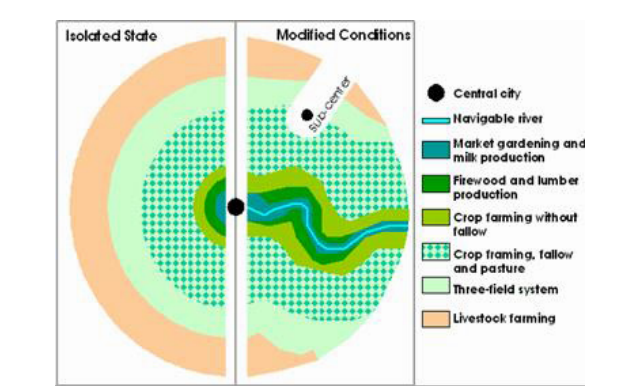
Johann Heinrich von Thünen’s theory of agricultural location, proposed in the early 19th century, remains remarkably relevant and applicable in today’s world, despite the profound changes in technology, transportation, and global economics. Von Thünen’s model, developed to understand the spatial organization of agricultural activities around a central market, continues to provide valuable insights into the dynamics of land use and resource allocation. In the contemporary context, where issues such as globalization, climate change, and sustainability shape agricultural practices, Von Thünen’s principles continue to offer a foundational framework for analyzing the spatial distribution of agricultural activities and the factors influencing farmers’ decisions on crop selection and land use. This enduring applicability underscores the theory’s enduring significance in informing contemporary discussions on efficient land use planning, transportation logistics, and the overall spatial arrangement of agricultural production in today’s complex and interconnected world.
Contents
- 1 Answer
- 1.1 Relevance and Applicability of Von Thunen’s theory in today’s world:
- 1.1.1 Von thunen’s Relevance in Understanding Transportation and Logistics Pattern
- 1.1.2 Urban Planning
- 1.1.3 Land Rent is Still Applicable
- 1.1.4 Spatial Organisation of Agriculture is Still in Accordance with Von thunen’s Model
- 1.1.5 Von thunen’s Applicability in Agribusiness Decisions
- 1.1.6 Von thunen’s Applicability in Understanding Rural-Urban Interface
- 1.2 Agricultural Land Use
- 1.3 Resource allocation
- 1.1 Relevance and Applicability of Von Thunen’s theory in today’s world:
- 2 In case you still have your doubts, contact us on 9811333901.
Answer
The Von Thünen theory of agricultural location,a normative theory,developed by Johann Heinrich von Thünen in the 19th century,was a manifestation of the Quantitative Revolution which was gaining importance in geographical studies post 1950’s.It provide insights into how spatial decisions regarding agricultural activities are influenced by proximity to markets.

Relevance and Applicability of Von Thunen’s theory in today’s world:
Von thunen’s Relevance in Understanding Transportation and Logistics Pattern
- The theory highlights the importance of transportation costs in determining crop and livestock choices.In today’s globalised world, it is relevant for optimising supply chains, minimising transportation costs, and reducing environmental impacts.

Urban Planning
- Many cities across the globe employ urban zoning regulations allocating different areas for residential,commercial,industrial and recreational purposes
- Eg.New York city’s zoning regulations determine locational decisions for parks, neighborhoods and skyscrapers.
Land Rent is Still Applicable
- Areas around the main market have high land rent which gradually decreases as we move away from the main market

Spatial Organisation of Agriculture is Still in Accordance with Von thunen’s Model
- Organic and Dairy farming is near to the market
- Hardy Crops and Grain production is in faraway areas

Von thunen’s Applicability in Agribusiness Decisions
- Agribusinesses still use this theory to make decisions about the location of farms, distribution centers, and processing facilities to minimize costs and maximize profits.
Von thunen’s Applicability in Understanding Rural-Urban Interface
- The theory highlights the economic interactions between rural and urban areas.
- Understanding this interface is crucial for addressing issues such as urban sprawl, land use conflicts, and the preservation of rural landscapes.
Agricultural Land Use
- Von Thünen’s theory can be applied globally, helping nations and regions make informed decisions about agricultural production, export-oriented farming, and food security.
Resource allocation
- The model underscores the economic principle of resource allocation,where land and resources are allocated to their most profitable use.
- This concept remains fundamental in today’s sustainable resource management and land conservation
While the world has changed significantly since the time of von Thünen, his insights into the spatial organization of agriculture continue to inform decisions in agriculture, land use planning, and logistics.
In case you still have your doubts, contact us on 9811333901.
For UPSC Prelims Resources, Click here
For Daily Updates and Study Material:
Join our Telegram Channel – Edukemy for IAS
- 1. Learn through Videos – here
- 2. Be Exam Ready by Practicing Daily MCQs – here
- 3. Daily Newsletter – Get all your Current Affairs Covered – here
- 4. Mains Answer Writing Practice – here

